Feeding Your Cat – Choosing a Food
Cats evolved as predators. They get most of their nutrition from meat. They have small stomachs and short gastrointestinal tracts designed to digest animal protein (meat). Cats are what we call “obligate carnivores” -they must eat meat, unlike dogs and humans who are omnivores (eat a combination of plant and animal foods).
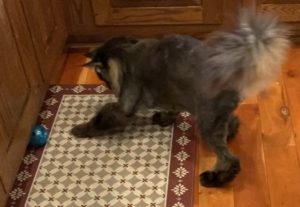
So what do I feed my cat? A diet high in protein.
How much protein?
- Feral cats consume of diet of about 52% kcal of protein and 46% kcal of fat.
- Nutrient Profiles of Feral-Cats
- Adult domestic cats when given the choice, eat 52% kcal protein, 36% kcal fat and 12% kcal carbohydrates
- Protein and carbohydrates provide about 4 kcal per gram of food, while fats supply 9 kcal per gram of food.
- A 100 kcal portion of food of choice for an adult domestic cat would contain about 13 g protein, 4 g fat and 3 g carbohydrates.
- The guaranteed analysis on the pet food label refers to weights of the nutrients.
The Label on the Cat Food
Pet food is regulated somewhat loosely – the The Association of American Feed Control Officials or AAFCO is an organization with no actual regulatory authority although individual members may have jurisdiction in their countries. The FDA is a member of AAFCO and has regulatory authority in the United States.
- AAFCO sets recommended standards for nutrient levels and ingredients in pet food.
- Most pet food manufacturers make their food to meet or exceed these requirements.
- AAFCO also provides models for feeding trials.
- AAFCO recommends a minimum of 26% crude protein in cat foods.
Don’t Forget the Water!
The label on a can of Purina Pro Plan canned cat food reports a minimum protein of 10%. The food has a maximum moisture level of 78%. The canned food has 100%-78% = 22% dry matter. Per 100g, 10g are protein, 78g are water resulting 12g of dry matter. 10g/22g = 0.45. Multiply by 100 to get 45% of crude protein dry matter.
Maintenance Diet Label
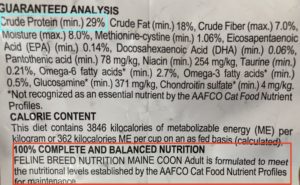
Note the protein exceeds the minimum of 26%. This food is for maintenance of adult cats.
Restricted Diet Label
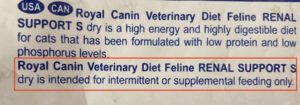
This is a label from a food designed for cats with kidney disease – it is lower in protein than a maintenance diet. It should be fed under the direction of a veterinarian. You may see this type of label on food toppers and other products that are not a balanced diet.
Feeding Trial Label
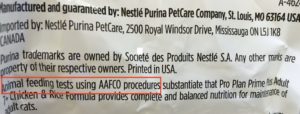
This food was tested by being fed to a cats in a research setting. Cats are monitored by evaluating their weight, stool, urine, and blood periodically.
Canned or Dry?
Cats will thrive on an all dry diet as well as a 100% canned diet. Cats appreciate variety and feeding your cat a mixture of canned and dry may fit the bill.
Canned Foods
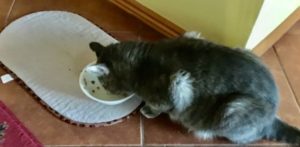
- most of the time (but not always) has more protein than dry food
- provides water to your cat
- cats in the wild get most of their water from the prey animals they eat
- Canned foods lend themselves to meal feeding
Dry Foods
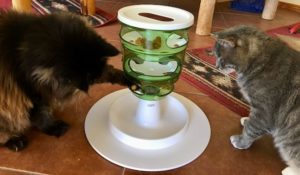
- convenient
- do not spoil when left out
- work well in puzzle feeders, that can provide your cat with some much needed stimulation while you are away
- Like potato chips for humans, dry cat foods are formulated to be tasty and are often high in calories.
Feeding Your Cat – Which Food?
- Choose a food that lists meat and/or fish at the top of the ingredient list.
- Choose a food that meets the AAFCO nutritional minimums.
- Choose a food from a reputable manufacturer, one that employs a veterinary nutritionist
- Beware of marketing that targets us, the owners. For example, some brands offer cranberries or blueberries in their foods. While not harmful, there are no clinical studies at this time that show the benefits of these ingredients to cats.



Michelle says:
This is very interesting and helpful. When I did the computation to figure out my cat food crude protein, I get a result different from the posting. 10g/12g= .83 not .45. Please advise! Many thanks ~
felinepurrspective_u3q4o6 says:
Oops! Thanks for catching that – 100%-78% = 22% not 12%. Then 10/22 = 0.45 or 45%.